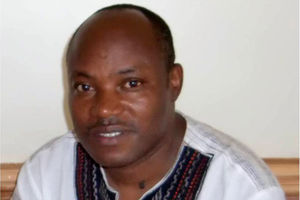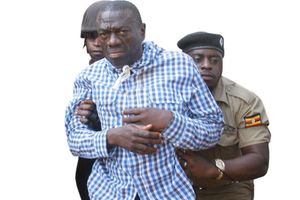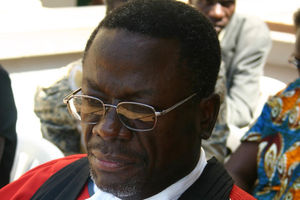
Col Ndahura Atwooki (right, seated) after taking over as operations and training officer for the 301 Brigade in Lira from Lt Col Anywar (left, seated). Centre is Gen Levi Karuhanga (RIP), who oversaw the handover.. PHOTO/COURTESY OF ANDREW BAGALA
In June 2001, President Museveni was expected in Rukungiri District in Kigezi Sub-region during the parliamentary elections in Kinkizi West in which Mr Amama Mbabazi of the National Resistance Movement (NRM) party and Mr Garuga Musinguzi, who was allied to the Opposition led by Col Kizza Besigye, were the main candidates.
As the military assistant to the President, Col Ndahura Atwooki Birakurataki, then at the rank of a Captain, was sent to Rukungiri District as an advance team under then Presidential Protection Unit (PPU), now Special Forces Command (SFC).
“There was a genocide brewing in Rukungiri District as Dr Kizza Besigye’s supporters used violence to silence their opponent. The genocide sentiments were against one community. I was sent there to do civil-military relations,” Col Ndahura remembers, adding that his objective was to save the people from intimidation while reassuring the communities that they would be protected by the government security agencies.
He recalls: “On the day I arrived, I got a shock when a man slapped a woman for shouting at President Museveni in Rukungiri Township. I wondered how a person could do such a thing in front of security personnel […] I made sure whoever participated in violence was arrested and produced in court as soon as it was practically possible.”
He says Dr Besigye and his supporters were incensed.
“He summoned his colleagues, led by [former Kampala City mayor] Nasser Ssebagala (RIP), who arrived with his group with the sole aim of uprooting the PPU,” he says of Dr Besigye.
Run-in with Besigye
On June 14, 2001, Dr Besigye’s group, in a convoy from Rwakabengo, advanced to the state lodge to uproot PPU per Col Ndahura’s recollection. On the way, Col Ndahura adds, they attacked NRM supporters.
“The victims were caught up on the fence. I built up a wall where Susan Muhwezi (wife of Maj Gen Jim Muhwezi) was. I was seeing casualties as bottles were being pelted,” he says, adding: “I worked with a lot of restraint. I didn’t have a big force. There were not more than 20 soldiers. I ordered them not to shoot and that the order to shoot would come from only me. Other soldiers at the scene, who were under a different commander at the rank of a Captain, had come from the garrison battalion.”
In the scuffle, Col Ndahura says he heard a senior military officer “shriek in pain” after being pelted with a stone.
“When he got up, he went running after the perpetrator in the corridor. He discharged a bullet that hit a man dead. When the police forensic officer investigated, he found out that the bullet was shot in the air, but it hit the wall, deflected before hitting one John Berondera,” Col Ndahura says.
Col Ndahura believes the person who stoned the officer was the one who was shot.
“The talk that I killed people as reported in one book titled [The] Correct Line[?], is false. It is rubbish. That is why I took them to court,” Col Ndahura says.
The book in question was written by Dr Olive Kobusingye, Dr Besigye’s younger sister. Col Ndahura sued the two siblings for defamation. Before the case could be heard in court, he was arrested and remanded by the army on allegations of failing to protect war materiel and illegal extradition of Rwandan nationals. He says during his detention, he couldn’t follow up on the case. Court ruled against Col Ndahura and also awarded Dr Besigye and his sister Shs350m.
Col Ndahura denies responsibility for the Rukungiri killing, insisting that a battalion commander at the scene was the overall commander.
Making inroads
After the 2001 General Election, Col Ndahura was appointed the operations and training officer for the 301 Brigade in Lira. He was the second-in-command for the brigade and the new position saw him promoted to Lieutenant Colonel. Shortly after, he was sent to India for a course. Upon his return, he was appointed division operations officer and also responsible for the recruitment of the Amuka militia.
In 2004, he was deployed in 503 Brigade in Kitgum. The Lord’s Resistance Army (LRA) rebels were still holed up in the area and his task was to flash them out.
“The rebels firmly held Nyono Hill and every attempt to capture it had failed. The place was a bit remote. Whenever troops were sent there, in one way or the other, they would fail to reach the hills […] they would run out of food before reaching the spot or get poor directions,” Col Ndahura says, adding: “I was seeing it on the map at the conference of River Aswa and River Pagali, but we had failed to reach there.”
Col Ndahura tried a traditional path to secure a victory against the LRA.
“During the fight with Alice Lakwena rebels at Corner Kilak then under Lira District, I had read her documents that we had seized attributing the losses to one of her rebels killing a pregnant Munyoro woman,” he sars.
Lakwena had indicated that in Acholi culture, it was taboo to kill a Munyoro.
“I asked Acholi traditional leaders and they told me it was true. So I used that traditional relationship between the Acholi and Banyoro in the war,” he says.
Some other Acholi elders had a lot of influence on the LRA rebels and often they secretly communicated. The Acholi elders’ opinion weighed a lot on the rebels.
Under the influence of Col Ndahura, the Acholi elders reached out to the rebels and convinced them that there was a need to cleanse Nyono Hills to enable them win the war against the government.
The Acholi traditional leaders and Col Ndahura agreed to have a ritual ceremony to cleanse the hills. LRA rebels were also briefed and agreed.
“My deputy, Col Noah Kabyanga, was a Munyoro, who was supposed to perform the ritual, but him being a Muslim, he declined, saying his religion forbids him from engaging in such practices,” Col Ndahura recalls, adding: “I took on the task since I didn’t believe in the existence of spiritual things. We slaughtered a white sheep and performed rituals. I moved to Nyono Hills where I did other things that I would like to keep to myself.”
When the rituals were completed, the rebels left the hills for the UPDF. Col Ndahura recalls that “there was no shooting, no fighting. Col Ndahura didn’t just get the guts to put his life in harm’s way. He convinced himself that in the Acholi culture, LRA could not kill a Munyoro, him inclusive, intentionally, but by mistake even during war.
Thorn in the flesh
Soon after, the rebels led by Maj Lakat, who was a key commander for the LRA, left the area for good. Joseph Kony, the LRA leader, had severally praised Maj Lakat for controlling Nyono Hills. Col Ndahura was in charge of Nyono Hills.
“I found out that there was a mobile phone network at the top of the hills. So I called Gen Otema Awany. He asked me where I was. I told him I was at Nyono Hills. He wondered how I got there,” he says.
The information reached the then Chief of Defence Forces, Gen Aronda Nyakairima, who “quickly sent a radio message to all army units, which indicated that I was the David Livingstone of Nyono Hills.” Dr David Livingstone was a famous British explorer considered by many people in the West to have discovered the source of River Nile in Uganda in the late 1800s.
Col (Rtd) Ben Sserwadda of the 21st Battalion took on the baton after Col Ndahura left with his force. This was after the latter was sent to another senior command course in Nairobi, Kenya, which took him nearly a year to complete.
From school, Col Ndahura was elevated to the division as the operations and training officer of the Third Division, which was based in the Karamoja Sub-region where Karimojong warriors were a thorn in the flesh.
“I was bothered by the warriors being in charge of Mulongo Hills. They would dare us to cross the line to reach the area under their control. How could they control a territory for some time when during the colonial government, they never did it?” he wondered.
Yet Col Ndahura’s division commander stopped him from carrying out an offensive. The warriors would often descend from the hilltop and cause mayhem and even move to neighbouring ethnic communities where they would raid cattle.
A single theft case of animals by the Karimojong warriors inflamed the people of Teso. Politicians would pick it from there and amplify it at the national level, leading to the sacking of army commanders.
“When my boss went for a course, the next day I went for a fight. Around 2,000 Turkana warriors were entering the country from the Kenya side, while another armed group from Sudan (now South Sudan) was moving south,” he says.
Fighting back
The group from South Sudan was about to reach Dodoth, a breeding place for ostriches that is pivotal to the tourism industry.
“I moved into action, establishing seven fronts at a go. We deployed all ground and air assets against the groups. Our armoured vehicles did an incredible job,” he remembers.”
“The situation was so hostile that it became a big political issue in Kenya since the UPDF had to deal with the Turkanas from Kenya. I had to deal with international media that were alleging that we were so harsh on the groups from Kenya.”
“Those warriors don’t use a conventional style like shooting from one side. This made it hard for us to contain them. They would shoot from all angles, even shooting their colleagues,” he recalls.
The battle was so intense that at one point, the then Land Force Commander, Gen Katumba Wamala (now Works and Transport minister), who had visited the area in Kotido District, was forced to pick up a rifle and personally engage in the fight.
“The gunships didn’t rest. They would fire and return to load and return to the theatre until we quelled the situation,” he says.
In the end, Col Ndahura captured Mulongo Hills and reached Katikile near the border.



